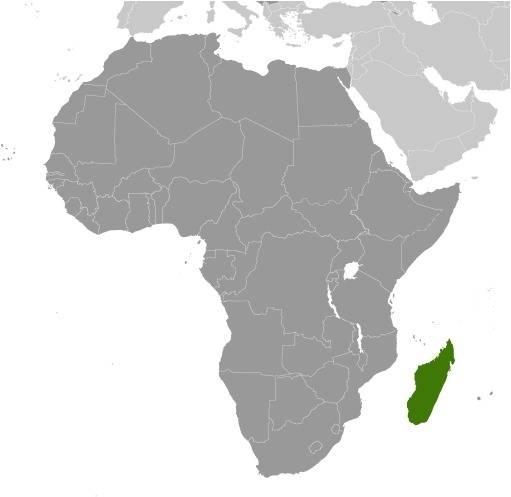Country Summary




Introduction
Background
Madagascar was one of the last major habitable landmasses on earth settled by humans. Madagascar was a pirate stronghold during the late 17th and early 18th centuries. The island was conquered by the French in 1896 who made it a colony. Independence was regained in 1960.
Geography
Area
total: 587,041 sq km
land: 581,540 sq km
water: 5,501 sq km
Climate
tropical along coast, temperate inland, arid in south
Natural resources
graphite, chromite, coal, bauxite, rare earth elements, salt, quartz, tar sands, semiprecious stones, mica, fish, hydropower
People and Society
Population
28,172,462 (2022 est.)
Ethnic groups
Malayo-Indonesian (Merina and related Betsileo), Cotiers (mixed African, Malayo-Indonesian, and Arab ancestry - Betsimisaraka, Tsimihety, Antaisaka, Sakalava), French, Indian, Creole, Comoran
Languages
Malagasy (official) 99.9%, French (official) 23.6%, English 8.2%, other 0.6% (2018 est.)
Religions
Church of Jesus Christ in Madagascar/Malagasy Lutheran Church/Anglican Church 34%, Roman Catholic 32.3%, other Christian 8.1%, traditional/Animist 1.7%, Muslim 1.4%, other 0.6%, none 21.9% (2021 est.)
Population growth rate
2.27% (2022 est.)
Government
Government type
semi-presidential republic
Capital
name: Antananarivo
Executive branch
chief of state: President Andry RAJOELINA (since 21 January 2019)
head of government: Prime Minister Christian NTSAY (since 6 June 2018)
Legislative branch
description: bicameral Parliament consists of:
Senate or Antenimieran-Doholona (18 seats; 12 members indirectly elected by an electoral college of municipal, communal, regional, and provincial leaders and 6 appointed by the president; members serve 5-year terms)
National Assembly or Antenimierampirenena (151 seats; 87 members directly elected in single-seat constituencies by simple majority vote and 64 directly elected in multi-seat constituencies by closed-list proportional representation vote; members serve 5-year terms)
Economy
Economic overview
low-income East African island economy; natural resource rich; extreme poverty; return of political stability has helped growth; sharp tax revenue drop due to COVID-19; leading vanilla producer; environmentally fragile
Real GDP (purchasing power parity)
$41.82 billion (2020 est.)
Real GDP per capita
$1,500 (2020 est.)
Agricultural products
rice, sugar cane, cassava, sweet potatoes, milk, vegetables, bananas, mangoes/guavas, tropical fruit, potatoes
Industries
meat processing, seafood, soap, beer, leather, sugar, textiles, glassware, cement, automobile assembly plant, paper, petroleum, tourism, mining
Exports
$4.09 billion (2019 est.)
Exports - partners
United States 19%, France 18%, United Arab Emirates 7%, China 6%, Japan 6%, Germany 5%, India 5% (2019)
Exports - commodities
vanilla, nickel, gold, clothing and apparel, gemstones (2019)
Imports
$4.7 billion (2019 est.)
Imports - partners
China 24%, France 11%, United Arab Emirates 9%, India 7%, South Africa 5% (2019)
Imports - commodities
refined petroleum, rice, cars, packaged medicines, clothing and apparel (2019)
Exchange rates
Malagasy ariary (MGA) per US dollar -
Page last updated: Tuesday, August 30, 2022
